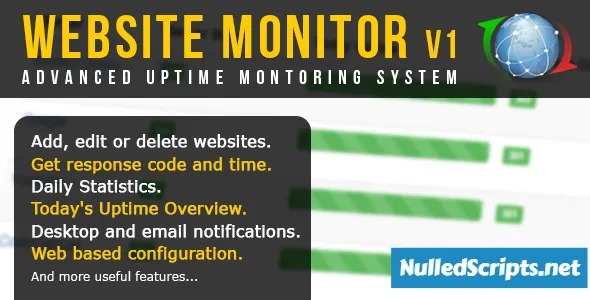
Item Details
With this advanced website availability monitor, you can easily check the uptime and response time of a website.
Features
Multi-Location Monitoring: These tools allow you to monitor your website's availability from multiple geographical locations. This helps in identifying regional outages or latency issues.
Real User Monitoring (RUM): RUM captures data from actual users visiting your site. It provides insights into their experiences, including page load times, browser types, and device information.
Transaction Monitoring: You can set up multi-step transactions (e.g., login, add to cart, checkout) to simulate user interactions on your site. The tool alerts you if any step fails.
Content Verification: These tools can verify that specific content or elements (e.g., a logo or text) exist on your site. If they disappear, you receive an alert.
API Monitoring: If your website relies on third-party APIs or services, you can monitor them to ensure they are working correctly. This is crucial for e-commerce and SaaS businesses.
Performance Metrics: In addition to uptime, advanced monitoring tools can provide performance data, including page load times, response times, and other critical performance metrics.
Alerting and Notifications: Receive alerts via multiple channels (email, SMS, push notifications) when your website experiences downtime or performance issues. Configure custom alert thresholds.
Custom Scripts and Plugins: Create custom scripts or plugins to monitor specific aspects of your site that are unique to your business. For example, you can monitor database queries or background jobs.
Historical Data and Reporting: Access historical data to track trends and view performance over time. Generate reports to assess your site's overall reliability.
Integrations: These tools often integrate with other monitoring and incident management tools like Slack, PagerDuty, or JIRA to streamline incident response and resolution.
SSL Certificate Monitoring: Ensure that your SSL certificates are up-to-date and valid to prevent security issues and browser warnings.
Blacklist and Reputation Monitoring: Check if your site's IP or domain is blacklisted on security and spam lists, which can affect your email deliverability and SEO.
Server Resource Monitoring: Monitor server resources (CPU, memory, disk space) to ensure that your hosting environment is not a bottleneck for your site's performance.
Distributed Denial of Service (DDoS) Detection: Detect and alert you about potential DDoS attacks that could affect your site's availability.
Mobile App Monitoring: If you have a mobile app, these tools can monitor its availability and performance on various devices and networks.
Predictive Analytics: Some tools use machine learning algorithms to predict potential issues before they cause downtime, allowing you to take proactive measures.
Custom Dashboards: Create custom dashboards to visualize data that's most important to your business, and share them with your team.
User Journey Mapping: Map out user journeys on your website to monitor the entire user experience and identify bottlenecks.
API and Webhook Support: Enable communication with other tools and services to automate actions based on monitoring alerts.
Compliance and Security Checks: Some tools offer compliance and security checks to ensure your website adheres to industry standards and best practices.





